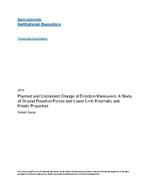|
|

Notes
- Abstract:
- The purpose of this study was to determine which of two conditions (planned and unplanned) would predispose a change of direction performer to a greater risk of anterior cruciate ligament (ACL) injury. This was done so as to enable trainers, coaches and athletes to better prepare the body for the condition that presented the greater risk, thereby lowering the overall level of potential injury that athletes are exposed to. Variables assessed were that of peak braking forces, peak vertical ground reaction forces (VGRFs), loading rates and peak valgus angles, measured at weight acceptance. Weight acceptance was defined as the period from contact of the foot to maximum knee flexion during the change of direction (COD) maneuver. Male, NCAA, Barry University, Division II athletes (N = 18) from the sports of basketball, baseball and soccer volunteered to be a part of the study. A repeated measure, within-subjects multivariate analysis of variance (MANOVA) was performed to assess the differences between planned and unplanned COD maneuvers, within subjects. Significance was displayed between planned and unplanned peak normalized braking forces F(1,17) = 21.577, p<0.001. In addition, statistical significance was displayed between planned and unplanned VGRFs F(1,17) = 12.681, p = 0.002. No statistical significance was displayed between the planned and unplanned conditions of loading rate F(1,17) = 3.968, p = 0.063 and peak valgus angles achieved F(1,17) = 2.537, p = 0.130. Statistical significance exists between planned and unplanned braking forces and VGRFs, with the unplanned conditions displaying greater values in magnitude during weight acceptance. These findings display the need for coaches, trainers and athletes to train the supporting muscles of the knee and neuromuscular responses more so for unplanned COD maneuvers to reduce injury risk.
- Thesis:
- Thesis (M.S.)--Barry University, 2016.
- Bibliography:
- Includes bibliographical references (leaves 59-60).
Record Information
- Source Institution:
- Barry University
- Holding Location:
- Barry University Archives and Special Collections
- Rights Management:
- Copyright Robert Saner. Permission granted to Barry University to digitize, archive and distribute this item for non-profit research and educational purposes. Any reuse of this item in excess of fair use or other copyright exemptions requires permission of the copyright holder.
- Resource Identifier:
- RA781.5.Z68 2016_SanerRobert ( BU-Local )
- Classification:
- RA781.5.Z68 2016 ( lcc )
|
|